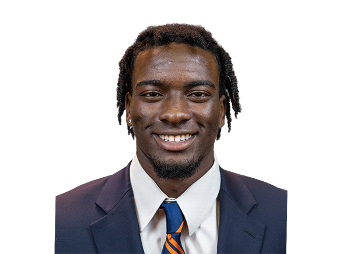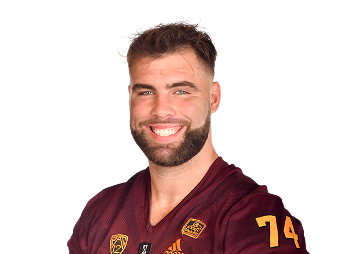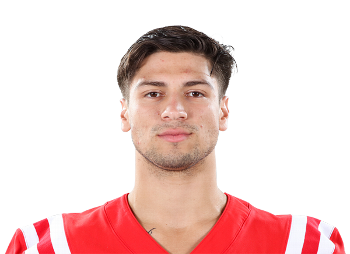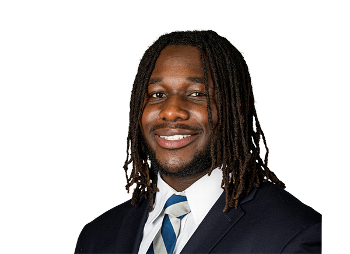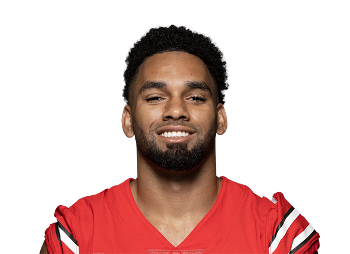Search Results
1553 results found with an empty search
- 404 | Football Scout 365
There’s Nothing Here... We can’t find the page you’re looking for. Check the URL, or head back home. Go Home
- 2022 NFL Draft Profile: Penn State WR Jahan Dotson
2022 NFL Draft Profile: Penn State WR Jahan Dotson Click Here to view our NFL Draft Big Board with player rankings and analysis. Click here to learn more about our updated player grade scale and critical position factors. Player Profile Name: Jahan Dotson School: Penn State Nittany Lions Recruiting Profile: Click Here Position: WR Height: 5-11 Weight: 185 Year: Senior Jersey Number: 5 Offensive Scheme: Air Raid, Spread, Vertical, Crossers Offensive Coordinator: Mike Yurcich Games Reviewed: 2020 Ohio State, 2020 Michigan, 2021 Michigan, 2021 Ohio State, 2021 Michigan State, 2021 Maryland, 2021 Wisconsin Position Specific Critical Factors Hands (8) Very Good The best WR's in football display great hands; they can snatch or pluck the football when in tight coverage or the wide-open field. Some receivers use their bodies when catching and therefore need more development as hands catchers. Separation (8) Very Good A player's ability to separate from a defender while running a route is dependent on his ability to run a precise and clean route. Separation is not just the prospect's ability to separate with speed, but his ability to run several routes at a high level. The prospect's ability to sell a route to get a defender out of position is also a key way for a player to gain separation. Players with a limited route tree can make it easier for defenders to predict their route running tendencies. The ability to use their body to box out is another way to gain separation. After Catch Ability (7) Very Good A running back with the football in their hands, receivers who can catch a football and make defenders miss in open space, or that can break tackles is a commodity at the highest level of football: high-level WR's show elusiveness, strength, speed, and display toughness after the catch. Key Strengths Route Running Hands Acceleration Key Weaknesses Strength Pass Game Summary Dotson is an established route runner in the passing game, with no limits to his route tree. He is a true route salesman with no wasted movement. Dotson is a speedy player with excellent short-area burst. He combines excellent route running with explosive speed to gain separation. He has great hands, and he is a consistent hands catcher that rarely drops an on-target throw. He attacks the catch point and plays with excellent spatial awareness. He can go up and make a play in tight coverage or locate the open areas and track the football at a high level. Dotson has a solid release at the line; he can deploy quick hands to swipe a defender's hands in press coverage. He has a nice crossover move that exhibits his basketball background to get initial separation at the line. With the ball in his hands, he can be allusive. He can make defenders miss if he has the room, and if he has the chance to hit top speed, he can house a play from anywhere on the field. Dotson is a high IQ player; you can see it in his route running and his situational awareness, where he locates the open areas of the field to gain separation. He is a first down machine, which exhibits his awareness; he knows where the sticks are at all times. Dotson provides positional versatility at the NFL level. He played all over as a receiver, X, Slot, and the Z in college. He has occasionally lined up at RB to confuse a defense, and he provides kick or punt return flexibility. Run Game Summary Dotson can be deployed on jet sweeps or out of the backfield in the run game. He possesses the speed and burst of a RB and is excellent in space with the ball in his hands. Dotson is a willing run blocker; though he is smaller, he carries his own. Final Analysis Jahan Dotson is one of the top receivers in this class due to his route running, awareness, and speed. At 5-11, he does not appear to be a physical style player, but he exhibits the ability to use his body to make a play in coverage. At the NFL level, Dotson will provide positional flexibility where he can move all-around a formation. He is a legitimate deep threat who can also make plays underneath, turning the short throws into explosive plays. Final Grade Analysis Final Grade: (7.0) (Instant Impact Potential) (9.0-7.0) High-End Starter Ceiling Grade: (7.2) (Instant Impact Potential) (9.0-7.0) High-End Starter Floor Grade: (6.7) (High Upside Potential) (6.9-6.7) Solid Starter Level
- Garrett Williams
< Back Garrett Williams Syracuse HT: 5100 WT: 192 YR: RSO POS: CB OVR RK 63 POS RK CEILING POTENTIAL 10 Mid-Level Starter Potential OVR RK PLAYSTYLE & SCHEME FIT CEILING GRADE ANALYSIS Mid-Level Starter Potential (60-64) A solid, dependable starter with the potential to exceed expectations. They have good athleticism and tools but may lack elite traits. While they show flashes of high-level play, they also have some notable weaknesses that must be developed. These players often need 2-3 years to establish themselves. Primary scout: Brandon Lundberg KEY STRENGTHS Physicality Closing Speed Run Support KEY WEAKNESSES Long Speed Locate Ball Aggressive PLAYER COMPARISONS
- Kellen Diesch
< Back Kellen Diesch Arizona State HT: 6070 WT: 300 YR: SR POS: IOL OVR RK 85 POS RK CEILING POTENTIAL 4 Mid-Level Starter Potential OVR RK PLAYSTYLE & SCHEME FIT CEILING GRADE ANALYSIS Mid-Level Starter Potential (60-64) A solid, dependable starter with the potential to exceed expectations. They have good athleticism and tools but may lack elite traits. While they show flashes of high-level play, they also have some notable weaknesses that must be developed. These players often need 2-3 years to establish themselves. Primary scout: Brandon Lundberg KEY STRENGTHS KEY WEAKNESSES PLAYER COMPARISONS
- Orange Bowl: Florida State vs. Georgia NFL Draft Prospects, Opt-Outs & Opt-Ins
Orange Bowl: Florida State vs. Georgia NFL Draft Prospects, Opt-Outs & Opt-Ins Florida State faces a massive challenge in the Orange Bowl against Georgia due to numerous key player opt-outs and transfers. This situation offers an early look at Florida State's potential 2024 roster and the depth and talent of the Georgia Bulldogs. Florida State Seminoles: Significant Player Opt-Outs and Draft Prospects Opt-Outs and Transfers : WR Keon Coleman : NFL draft opt-out, major loss for FSU's receiving corps. DE Jared Verse : NFL draft opt-out, significant impact on the defensive line. RB Trey Benson : Opt-out, the team's leading rusher. QB Tate Rodemaker : Transfer Portal departure, affecting the quarterback depth. Additional Opt-Outs/Transfers : WR Johnny Wilson, TE Jaheim Bell, and others. Key Draft Prospects Expected To Play: Braden Fiske (DT) : Top 2024 prospect, known for his strong play and high energy. Kalen DeLoach (LB) : 2024 prospect, versatile and dynamic defender. Patrick Payton (EDGE, 2025) : Future prospect with impressive length and flexibility. FSU Season Recap: Challenged by injuries, notably to QB Jordan Travis. Strong season finish but missed the College Football Playoff due to ranking drop. FSU Orange Bowl Strategy: Relying on depth and resilience, testing lesser-known players against a tough opponent. Georgia Bulldogs: Player Status and Draft Prospects Player Status : TE Brock Bowers : Questionable (Ankle/Possible Opt-Out). OT Amarius Mims : Injury concern, unclear participation. CB Kamari Lassiter : Top-50 2024 prospect, playing in the Orange Bowl. DB Javon Bullard : Versatile 2024 prospect. QB Carson Beck (2025) : Potential leading quarterback for the 2025 draft. UGA Team Strengths: Less impacted by opt-outs, maintaining a cohesive and strong roster. UGA Orange Bowl Strategy: Capitalize on Florida State's weakened roster by exploiting key player absences. Key Matchup Dynamics FSU's Adaptability : Can FSU overcome the loss of key players and show depth? Georgia's Roster Advantage : Will Georgia's intact roster lead to a decisive victory?
- 2021 NFL Draft Safety Rankings Re-Evaluated
2021 NFL Draft Safety Rankings Re-Evaluated As we move through the pro days and hear the noise of outlandish forty times and verticals through the roof, I have personally gone through and done more research on every position. The Football Scout 365 Big Board Don't forget to check out the full Football Scout 365 NFL Draft Big Board. After Further Review NFL Draft Edition On YouTube You can check out our Football Scout 365 After Further Review NFL Draft Edition on Youtube. We have five shows so far, three covering the QB position where I break down and connect the dots between player skillset and what the player displays on film concerning such buzzwords like arm talent, arm angle, pocket presence etc. Go To The NFL Draft Guide To View More Content by Clicking Here. What I look for when evaluating a DB. Whether it's a safety or CB, I am looking for similar traits. It starts with the scheme fit and how they translate. Can they adapt to different schemes? Are they more comfortable as a man-to-man defender vs. zone? Are they able to play press-man? Speed and burst matter in the secondary, but speed doesn't matter if a player lacks agility and good technique. Players with quick feet and can react quickly on the fly by flipping their hips are valuable. What do I mean by flipping the hips? Going from your back peddle to a full sprint fast is very important to a DB. The critical part of that transition is flipping your hips to change your body orientation 180 degrees without momentum. It's an awkward body motion that guys at the NFL level make look easy. I also look for willing-run defenders. Can they provide support in the run game? Are they sound in the open field? All of the above can be true for the safety position, but there are some differentiating factors from a CB. You have two safeties in football, free and strong, and sometimes you get a hybrid nickel or LB style safety. The definition of safety has become blurry as they have to be responsible in similar ways at both spots; that's where the hybrid effect comes into play or the undefined role of safety, so to speak, because of how defenses utilize them to defend against pass-heavy spread offenses. So you can understand the difference between a traditional free and strong safety, I'll define it real fast. Free safety is often the deep safety lined up at least 10 yards deep, while the strong safety traditionally lines up on the TE side or the heavy side of an offensive formation. Free safeties are responsible for mostly pass coverage, while a strong safety defends the run while also being accountable for pass coverage. 2021 NFL Draft IDL Rankings Okay, so let's dive into the safety rankings; 1) Oregon S Jevon Holland 6-1 196 lbs Potential Upside Player Holland is known as a leader and a great communicator. He is an agile fluid player who can move into the slot when needed. Holland has CB skills at the safety position. His flexibility adds to his value. He could play corner in the NFL. 2) TCU S Trevon Moehrig 6-1 208 lbs Potential Upside Player A free safety who has lined up in a myriad of spots under Head Coach Gary Patterson, often in a single-high look. He finds the football; he is a ball hawk who does an excellent job at breaking up the football at the catch point. He must improve as a run defender at the next level. 3) USC S Talanoa Hufanga 6-1 215 lbs Potential Upside Player A physical safety who can play deep or in the box. He is strong against the run, and his appeal to NFL GM's places him in the mold of the Derwin James, Jamal Adams style of player. He plays with a violent edge and enjoys contact. He plays with good instincts. He can play zone coverage, and he does well-matched against TE's. Past injury history might be the red flag for some GM's. He has broken his collarbone two times and has dislocated a shoulder. I can attest that it will wear on your body when you try to bring the wood consistently. 4) Georgia S Richard LeCounte III 5-11 190 lbs Potential Upside Player LeCounte communicates well in the secondary is a smart player who can play both man and zone coverage. He can lineup in the slot when needed. He plays with great balance but plays tight at times. LeCounte is a willing special teams player. 5) UCF S Richie Grant 6-0 194 lbs Potential Upside Player Grant is a versatile safety who has played several different roles in the UCF secondary. He is solid in both man and zone coverage and has played a box safety role as well. He projects as a free safety in the NFL. He needs to improve his on-field awareness and tackling. Go To The NFL Draft Guide To View More Content by Clicking Here.
- Matt Corral
Matt Corral has the athleticism NFL scouts and GM's want in today's QB, and he can extend plays outside of the pocket and is accurate while on the move. In addition, he can extend drives in key third-down situations with his legs. Corral benefits from the use of an RPO-heavy scheme. He is also very with zone read. His ability to put pressure on a defense with his legs is a paramount aspect of his game but can be an issue in the NFL, where athletes are faster at every position. He will have to learn to get down quickly and not take unnecessary contact. As a passer, Corral is a player who will need to be in an offense that uses a lot of quick throws and RPO's to get the ball out fast early in his career so that he can improve his ability to go through progressions and to take the check down if available. He doesn't possess an elite arm, but he does possess good mechanics and a quick release. His decision-making has improved since 2020, he does not take as many risks, but it is something to keep an eye on. He did worse with throws under pressure than when kept clean in 2021. < Back Matt Corral Ole Miss HT: 6010 WT: 205 YR: JR POS: QB OVR RK 61 POS RK CEILING POTENTIAL 5 Low-Level Starter Potential OVR RK PLAYSTYLE & SCHEME FIT Matt Corral has the athleticism NFL scouts and GM's want in today's QB, and he can extend plays outside of the pocket and is accurate while on the move. In addition, he can extend drives in key third-down situations with his legs. Corral benefits from the use of an RPO-heavy scheme. He is also very with zone read. His ability to put pressure on a defense with his legs is a paramount aspect of his game but can be an issue in the NFL, where athletes are faster at every position. He will have to learn to get down quickly and not take unnecessary contact. As a passer, Corral is a player who will need to be in an offense that uses a lot of quick throws and RPO's to get the ball out fast early in his career so that he can improve his ability to go through progressions and to take the check down if available. He doesn't possess an elite arm, but he does possess good mechanics and a quick release. His decision-making has improved since 2020, he does not take as many risks, but it is something to keep an eye on. He did worse with throws under pressure than when kept clean in 2021. CEILING GRADE ANALYSIS Low-Level Starter Potential (55-59) A player with the upside to be a low-end starter or high-level backup within a couple of seasons. While they have solid physical tools, inconsistencies in technique, processing, or durability limit their ceiling. They are developmental prospects who may carve out a role as specialists or system fits. Primary scout: Brandon Lundberg KEY STRENGTHS KEY WEAKNESSES PLAYER COMPARISONS
- Jesse Luketa
< Back Jesse Luketa Penn State HT: 6030 WT: 247 YR: SR POS: ED OVR RK 75 POS RK CEILING POTENTIAL 13 Mid-Level Starter Potential OVR RK PLAYSTYLE & SCHEME FIT CEILING GRADE ANALYSIS Mid-Level Starter Potential (60-64) A solid, dependable starter with the potential to exceed expectations. They have good athleticism and tools but may lack elite traits. While they show flashes of high-level play, they also have some notable weaknesses that must be developed. These players often need 2-3 years to establish themselves. Primary scout: Brandon Lundberg KEY STRENGTHS KEY WEAKNESSES PLAYER COMPARISONS
- Charlie Jones
< Back Charlie Jones Purdue HT: 5112 WT: 175 YR: SR POS: WR OVR RK 95 POS RK CEILING POTENTIAL 15 High-End Starter Potential OVR RK PLAYSTYLE & SCHEME FIT CEILING GRADE ANALYSIS High-End Starter Potential (65-69) A player expected to become a top-tier starter within their first few years. They possess strong physical tools and good technical skills but may have some limitations in their game. With development, they can reach near-elite levels and provide consistent impact at their position. Primary scout: Brandon Lundberg KEY STRENGTHS Football IQ Spatial Awareness Quick Release KEY WEAKNESSES Explosiveness Athleticism Physicality PLAYER COMPARISONS Bisi Johnson Keelan Cole Paul Richardson
- Chris Olave
Chris Olave is another talented Ohio State WR labeled with the technician tag similar to players in recent years, the most notable being Terry McLaurin. But Olave is more than just a technician. In addition to his route running, he is a serious deep threat with a high-level ability to track the football while being covered. He is not always a hands catcher, which can improve, but he possesses excellent body control in tight quarters, especially on back shoulder catches that he often makes look easy. Olave will not wow you physically, and at the NFL level, he will play in the slot or the z in an off-ball role where he will get a free release. If needed, he could step into an on-ball role using his short-area quickness off the line of scrimmage to get a free release. Olave excels at every level of the field; while he is not as elite after the catch as his Ohio State teammates, he is elusive enough to make a man miss in space where he can pick up the extra yards. Olave has instant impact potential right away. He can play a featured role at the NFL level. He can flourish in an offense that successfully utilizes a combination of horizontal, vertical, and option routes with a good balance of play action. His ability as a run blocker is adequate and will translate at the next level due to the Ohio States' enhanced focus on WR run blocking. He is also a solid special teams player who has blocked punts. Olave has a similar skill set to Tyler Locket, combining route running with deep ball tracking while playing an off-the-ball role from the Z or the slot. < Back Chris Olave Ohio State HT: 6010 WT: 188 YR: SR POS: WR OVR RK 14 POS RK CEILING POTENTIAL 2 Near Elite OVR RK PLAYSTYLE & SCHEME FIT Chris Olave is another talented Ohio State WR labeled with the technician tag similar to players in recent years, the most notable being Terry McLaurin. But Olave is more than just a technician. In addition to his route running, he is a serious deep threat with a high-level ability to track the football while being covered. He is not always a hands catcher, which can improve, but he possesses excellent body control in tight quarters, especially on back shoulder catches that he often makes look easy. Olave will not wow you physically, and at the NFL level, he will play in the slot or the z in an off-ball role where he will get a free release. If needed, he could step into an on-ball role using his short-area quickness off the line of scrimmage to get a free release. Olave excels at every level of the field; while he is not as elite after the catch as his Ohio State teammates, he is elusive enough to make a man miss in space where he can pick up the extra yards. Olave has instant impact potential right away. He can play a featured role at the NFL level. He can flourish in an offense that successfully utilizes a combination of horizontal, vertical, and option routes with a good balance of play action. His ability as a run blocker is adequate and will translate at the next level due to the Ohio States' enhanced focus on WR run blocking. He is also a solid special teams player who has blocked punts. Olave has a similar skill set to Tyler Locket, combining route running with deep ball tracking while playing an off-the-ball role from the Z or the slot. CEILING GRADE ANALYSIS Near Elite (70-74) A high-caliber prospect who is expected to become a significant contributor by Year 2. These players have outstanding physical tools and strong football IQ, with only minor flaws in their game. They demonstrate consistency at a high level and project as future Pro Bowl-caliber players if properly developed. Primary scout: Brandon Lundberg KEY STRENGTHS KEY WEAKNESSES PLAYER COMPARISONS
- Oregon vs. Ohio State: Buckeyes Aim to Prove Physicality, Ducks Seek Big Ten Validation
Oregon vs. Ohio State: Buckeyes Aim to Prove Physicality, Ducks Seek Big Ten Validation Buckeyes strive to prove their toughness, while the Ducks aim to validate their Big Ten readiness in a crucial 2024 showdown. How to Watch: No. 3 Oregon Ducks take on the No. 2 Ohio State Buckeyes in one of 2024's biggest college football matchups. Preview and prediction for the showdown at Autzen Stadium on Saturday, Oct. 12, with kickoff at 7:30 p.m. on NBC. The 2024 college football season is critical for the Ohio State Buckeyes, a team on a mission to redefine its reputation. Recent seasons have not been kind, as Ohio State faced stinging criticism after three consecutive losses to their arch-rival, Michigan, from 2021 to 2023. These defeats led many to label them a "finesse" team, and head coach Ryan Day knew that a cultural shift was necessary. With a renewed emphasis on physicality, particularly within the trenches, Ohio State looks to prove that it’s more than just hype. The upcoming showdown against the Oregon Ducks, who have recently joined the Big Ten, serves as the perfect proving ground for this transformation. Oregon, on the other hand, is in the midst of its own adaptation process. Adjusting to the physicality and demands of Big Ten football has been a considerable challenge for the Ducks, who previously dominated in the less physical, speed-oriented Pac-12. Head coach Dan Lanning is guiding the team through this transition, with the matchup against Ohio State providing an opportunity to measure their progress. This isn’t just another regular-season contest; it’s a pivotal clash that could shape the identity of both programs. A decisive performance by Ohio State would validate their commitment to toughness, while a strong showing by Oregon would signal their readiness to be a competitive force in the Big Ten. Ohio State Run Offense vs. Oregon Run Defense Ohio State's Rushing Attack Ohio State’s ground game has been a juggernaut, showcasing dominance across Power Four teams. The Buckeyes average 6.2 yards per carry and accumulate an impressive 221.6 rushing yards per game, placing them 2nd in yards per attempt nationally. The dynamic backfield duo of Quinshon Judkins and TreVeyon Henderson powers this efficiency. Judkins, averaging 7.8 yards per carry, has established himself as a consistent playmaker, while Henderson’s explosive 8.0 yards per carry adds another layer of threat to the Buckeyes’ ground attack. Ohio State’s offensive line is anchored by standouts like Seth McLaughlin (PFF grade: 82.9) and Josh Simmons (PFF grade: 89.0), both instrumental in creating clean lanes for their running backs. This cohesive unit excels in minimizing stuff rates (13%) and maximizing yards after contact, making Ohio State a formidable challenge for any defensive front. Can Oregon Contain the Ohio State Run Game? Oregon's defense faces a significant test, as their performance against the run has shown inconsistencies. Ranked 51st in yards per attempt allowed and 47th in yards after contact per attempt, the Ducks struggle to maintain gap integrity consistently. Jordan Burch (PFF grade: 63.9) and Derrick Harmon (PFF grade: 64.7) are key figures on the defensive line, yet they must elevate their performance to match Ohio State’s physical style of play. Oregon currently allows 4.8 yards per carry and 117.8 rushing yards per game, ranking 41st among Power Four teams in rushing yards allowed. To contain Ohio State's ground attack, these players must elevate their level of play and dominate at the point of attack. Oregon Run Offense vs. Ohio State Run Defense Oregon’s Ground Game Oregon’s rushing attack, led by Jordan James, has been effective, averaging 4.6 yards per carry and totaling 164.4 yards per game. Although they rank in the middle of the pack among Power Four teams, their offensive line, spearheaded by Iapani Laloulu (PFF grade: 81.1) and Josh Conerly Jr. (PFF grade: 77.7), has demonstrated the ability to create lanes for explosive plays. Oregon’s approach emphasizes breaking tackles, as shown by their 20% broken/missed tackle rate, highlighting their potential for generating yards after contact. However, against an elite Ohio State defensive front, Oregon's line must maintain its physicality and consistency. Laloulu and Conerly, as well as the rest of the Oregon offensive line, will need to win their individual matchups to open opportunities for James in the run game. Ohio State's Stout Defensive Front Ohio State’s defense ranks 3rd among Power Four teams, limiting opponents to just 3.2 yards per carry and 90.2 rushing yards per game while posting an impressive 27.5% stuff rate, showcasing their dominance in the trenches. Led by Tyliek Williams (PFF grade: 91.8) and Jack Sawyer (PFF grade: 85.1), the Buckeyes excel at controlling the line of scrimmage and disrupting run plays, making them a formidable force against any rushing attack. Williams has been a standout in the trenches, using his strength to plug gaps and prevent runs from developing, while Sawyer’s ability to set the edge and chase down plays adds another layer of difficulty for opposing offenses. Players in the Ohio State secondary have been outstanding in run support this season, led by Lathan Ransom (PFF grade: 93.8), who has been quick to read plays and close down lanes effectively. Caleb Downs (PFF grade: 76.6) and Jordan Hancock (PFF grade: 72.5) have also contributed significantly, showcasing their ability to provide support near the line of scrimmage. Final Thoughts Ohio State's Run Offense vs. Oregon's Run Defense: Ohio State’s powerful ground game, anchored by their dynamic running back duo and an elite offensive line, gives them a clear edge. Oregon's defense, despite the talents of players like Burch and Harmon, has shown vulnerabilities in containing yards per attempt, making them susceptible to Ohio State’s explosive rushing attack led by Judkins and Henderson. Oregon's Run Offense vs. Ohio State's Run Defense: Ohio State’s defense will be a tough task for the Oregon offense, boasting one of the top-ranked defensive units in the country. With standout players at all three levels and an elite defensive front, the Buckeyes have consistently shut down opposing run games. Oregon may not have a lot of consistent success in the run game, but they cannot give up on it. Ohio State Pass Offense vs. Oregon Pass Defense Will Howard’s Efficiency Will Be Key Ohio State quarterback Will Howard, while effective overall (71.5% completion rate), shows a decline in efficiency when it comes to deep throws. His completion rate on passes of 20+ yards stands at 45.5%. Despite averaging 17.8 yards per attempt on deep shots, inconsistency remains a concern. Howard has completed only 5 of 11 deep attempts this season for 196 yards, with one touchdown and one interception. His adjusted deep accuracy percentage (45.5%) ranks him in the middle tier nationally compared to other elite quarterbacks. This inconsistency provides Oregon an opportunity—if they can maintain coverage long enough to force Howard into challenging throws. However, for this to happen, the Ducks’ pass rush must be effective. Without consistent pressure, Oregon’s coverage grades suffer, and their defensive backs are more vulnerable. Oregon’s Secondary Vulnerabilities Oregon’s secondary, featuring players like Jabbar Muhammad and Brandon Johnson, faces one of its toughest tests against Ohio State's potent passing attack. With elite receivers like Jeremiah Smith and Emeka Egbuka, Oregon’s defensive backs must elevate their performance to contain Ohio State’s passing game. Oregon allows an 18.8% completion rate on deep throws (20+ air yards). However, they become significantly more vulnerable without pressure. On non-pressured deep throws, Oregon allows an average of 11.1 yards per attempt and a passer rating of 33.8, highlighting that when the pass rush is absent, quarterbacks can exploit coverage gaps. On the other hand, the secondary improves when pressure is applied, showing a 0% completion rate and 0 yards per attempt on pressured throws of 20+ yards yards or more. Nevertheless, their overall yards per coverage snap stands at 6.9, indicating that they tend to be substantial gains when deep throws connect. While Oregon's secondary displays some resilience with a low completion percentage on deep throws, the data reveals significant issues when they fail to pressure the quarterback. The yards allowed per attempt (particularly in non-pressured situations) and the elevated passer rating indicate that teams with adequate time in the pocket can exploit Oregon's coverage. To mitigate these deep threats, Oregon must maintain consistent pressure to limit big plays. Oregon Pass Offense vs. Ohio State Pass Defense Can The Ducks Challenge The Buckeyes Through the Air? Oregon’s passing game, led by quarterback Dillon Gabriel, averages 289.8 yards per game, placing them among the top 15 nationally. Gabriel has completed 78% of his passes for 1,449 yards and 11 touchdowns, displaying impressive efficiency and consistency. Oregon’s ability to utilize playmakers like Tez Johnson and Traeshon Holden makes their passing game versatile, capable of attacking various levels of the defense. Johnson’s speed and route-running precision provide a consistent downfield threat, while Terrance Ferguson’s size as a tight end gives Gabriel a reliable option underneath and in the middle of the field. Oregon’s offensive line, anchored by Iapani Laloulu (PFF grade: 81.1) and Josh Conerly Jr. (PFF grade: 77.7), has protected Gabriel effectively, ensuring he has time to find open targets. This protection will be critical as Oregon attempts to spread out Ohio State’s defense and exploit matchups against linebackers and safeties. Can The Buckeye Secondary Keep The Ducks In The Pond? Ohio State’s defense has been dominant against opposing pass offenses. Cornerback Denzel Burke (PFF grade: 71.6) and safety Lathan Ransom (PFF grade: 93.8) have excelled, allowing Ohio State to limit opponents to just 6.8 points per game. The front seven, featuring Jack Sawyer (PFF grade: 85.1) and JT Tuimoloau (PFF grade: 77.1), has been relentless, recording 17 sacks this season. Sawyer’s ability to disrupt plays off the edge will be crucial in challenging Oregon’s offensive line. Ohio State’s secondary, anchored by Burke, has also been effective at preventing big plays. Ransom’s versatility allows him to assist in coverage and support the run, forming a well-rounded and adaptable defense. The Buckeyes rank in the top 10 nationally in pass yards allowed per game and have consistently created turnovers, with 14 passes defended and four interceptions. Final Thoughts Ohio State's Pass Offense vs. Oregon's Pass Defense: Ohio State has a clear advantage with their dynamic quarterback-receiver duo and strong offensive line. Oregon’s secondary has shown potential weaknesses, and unless they can generate consistent pressure, Howard and his receivers are poised to exploit those weaknesses. Oregon's Pass Offense vs. Ohio State's Pass Defense: Ohio State’s defense is well-positioned to contain Oregon’s passing attack. With dominant performances from their front and solid secondary play led by Ransom, the Buckeyes have consistently stifled opposing air games. Oregon’s success will depend on their ability to protect Gabriel and execute quick, efficient completions to counter Ohio State’s pressure.
- Eric Stokes
< Back Eric Stokes Georgia HT: 6010 WT: 185 YR: RJR POS: CB OVR RK 59 POS RK CEILING POTENTIAL 6 High-End Starter Potential OVR RK PLAYSTYLE & SCHEME FIT CEILING GRADE ANALYSIS High-End Starter Potential (65-69) A player expected to become a top-tier starter within their first few years. They possess strong physical tools and good technical skills but may have some limitations in their game. With development, they can reach near-elite levels and provide consistent impact at their position. Primary scout: Brandon Lundberg KEY STRENGTHS KEY WEAKNESSES PLAYER COMPARISONS




